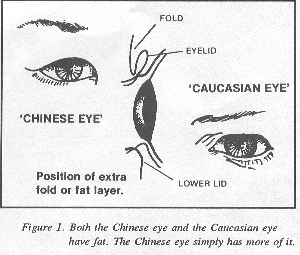
According to the Bible, all humans on earth today are descended from Noah and his wife, his three sons and their wives, and before that from Adam and Eve. It is obvious that we have many different groups or races with what seem to be greatly differing features. The most obvious of these is skin color. Many see this as a reason to doubt the Bible's record of history. They believe that the various groups could have arisen only by evolving separately over tens of thousands of years.
As will be seen, this is not so. Modern knowledge of how features such as skin color are inherited shows that it would have taken only a few generations after an event such as the Bible records as having happened at Babel to produce many different groups with distinct characteristics. And there is good evidence to show that, in fact, the various groups of people we have today have not been separated for
huge periods of time.
In one sense, of course, there is only one race - the human race. The Bible teaches us that God has "made of one blood all nations of men " (Acts 17:26). Scripture distinguishes people by tribal or national groupings, not by skin color or physical appearances. Clearly, though, there are groups of people who have certain features (e.g. , skin color) in common, which makes them different from other groups. For convenience, we shall refer to these groups as races, since the human races are all part of one species - Homo sapiens (wise man). This, of course, tells us immediately that all races can freely interbreed and produce fertile offspring; if not, they would have to be classified as separate species. This indicates that the biological differences between the races are not very great.
Anthropologists generally classify people into a fairly small number of main racial groups, such as the Caucasoid, the Mongoloid (which includes, for example, the American Indians), the Negroid, and the Australoid (the Australian Aborigines). Within each classification, there may be many different sub-groups.
Virtually all evolutionists would agree that the various races of men did not have separate origins, that is, they did not each evolve from a different group of animals, for instance. So they would agree with the Biblical creationist that all races have come from the same original population. Of course, they believe that such groups as the Aborigines and the Chinese have had many, many tens of thousands of years of separation, and most people believe that there are such vast differences between the races that there had to be many years for these differences to somehow develop.
One reason for this is that people believe that some races have unique features in their hereditary make-up which others do not. This is an understandable but incorrect idea. Let's look at skin color, for instance. It is easy to think that since different groups of people have yellow skin, red skin, black skin, white skin, and brown skin, there must be many different skin pigments or colorings. And since different chemicals for coloring would mean a different genetic recipe or code in the hereditary blueprint in each race, it appears to be a real problem. How could all those differences be present within a short time?
The fact is, however, that there is only one skin color : melanin. This is a brownish pigment which we all have in special cells in our skin. If we have none (as do people called albinos, who suffer from an inherited mutation-caused defect, which means they lack the ability to produce melanin), then we will have a very white skin coloring (actually pink-white because of blood vessels showing through the skin). If we produce only a little melanin, it means that we will be European white. If our skin produces a great deal of melanin, we will be a very deep black. And in between, of course, are all shades of brown. There are no other skin pigments; other factors such as the extra thickness of the overlying skin in the Chinese, for example, can give a yellowish effect. And this is not only true for skin color. Whatever feature we may look at, no race has anything which is, in its essence, uniquely different from that possessed by another. For example, the Chinese eye, or almond eye, gets its appearance simply by having an extra fold of fat (see Figure I). Both Chinese and Caucasian eyes have fat - the latter simply have less of it.

We will shortly see how all the shades of skin color would take only a very short time to come about, but first let's just find out what melanin is for. It protects the skin against the effects of sunlight. If you have too little in a very sunny environment, you will very easily suffer from sunburn and skin cancer. If you have a great deal of melanin, and you live in a country where there is little sunshine, it is much harder for your body to get adequate amounts of vitamin D (which needs sunshine for its production in your body), and you may suffer from vitamin D deficiency, which could cause a bone disorder such as rickets.
We also need to be aware that one is not born with a genetically fixed amount of melanin, but rather with a genetically fixed potential to produce a certain amount in response to sunlight. For example, if you are a Caucasian, you may have noticed that when your friends headed for the beach at the very beginning of summer, they may, if they spent all their time indoors during winter, have all been more or less the same pale white. As the summer went on, however, some became much darker than others. Even very dark- skinned races are not born with such a skin color. It takes exposure to sunlight to switch on the melanin factories in the skin. In very dark-skinned people, the areas such as the palms of the hands and the soles of the feet, which are very rarely exposed to sunlight, generally stay much lighter than the rest of the body.
Let's look at a few observations which can help us to explain how many different skin colors can arise in a short time. (From here on, whenever we use such words as different colors we are, strictly speaking, referring to different shades of the one color.) If a person from a very black race marries someone from a very white race, their offspring (called mulattos) are mid-brown. It has long been known that if people of mulatto descent marry, their offspring may be virtually any color, ranging from very black to very white. Understanding this gives us the clues we need for our overall question, so we must first look, in a simple way, at some of the basic facts of heredity.
Each of us carries in our body information which describes us in the way a blueprint describes a finished building. It determines not only that we will be human beings, rather than cabbages or crocodiles, but also whether we will have blue eyes, short nose, long legs, etc. When a male sperm fertilizes an egg, all the information that specifies how the person will be built (ignoring such superimposed factors as exercise and diet) is already present. This information is not in written form, at least not in an ordinary type of language, but it is written down in one sense. A piece of string with beads on it can carry a message in Morse code (see diagram below).

Can you see how the piece of string, by the use of a simple sequence of short beads, long beads, and spaces (to represent the dots and dashes of Morse code), can carry the same information as the English word "help" typed on a sheet of paper? The entire Encyclopaedia Britannica could be written thus in Morse Code on a long-enough piece of string.
In a similar way, the human blueprint is written in a code (or language convention) which is carried on a very long chemical called DNA.
The word "gene" means a small part of that information which carries the instructions for only one feature. A small length of string with only one specification on it is a simple way of understanding it.
For example, there is one gene which carries the instructions on how to make haemoglobin, the chemical which carries oxygen in your red blood cells. If that gene has been damaged by mutation, the instructions will be faulty, so it will make a crippled form of haemoglobin, if any. (There are a number of diseases, e.g., sickle-cell anaemia and thalassaemia, which result from such mistakes, called mutations.)
So, going back to that cell, that egg which has just been fertilized - where does all its information, its genes, come from? One half has come from the father (carried by the sperm), and the other half from the mother (carried in the egg). Genes come in matching pairs, so in the case of haemoglobin, for example, we have two genes, which both contain the code (instruction) for haemoglobin manufacture, one from the mother and one from the father. This is a very useful arrangement, because if you inherit a gene from one parent which is damaged and can instruct your cells to produce only a defective haemoglobin, the other one from the other parent will continue to give the right instructions, so that only half the haemoglobin in your body is defective. (In fact, each of us carries hundreds of mistakes, inherited from one or the other of our parents, which are usefully covered up by being matched with a normal gene from the other parent.)
Let's take another example, to ensure that before we talk about skin color you will have a good basic understanding of heredity (simplified, of course). Blue and brown eyes are also a result of whether you have melanin in the iris of your eye. If you have it, your eyes are brown; if not, they appear )bIue, but they are, in fact, non-brown, (The sky appears )bIue, but has no blue coloring chemical in it.)
Let's call the gene which gives the instructions to make melanin in your iris B. This gene says to your cells, in effect, "Make melanin for the iris." There is another gene (let's call it b) which occupies the same place in the blueprint, and which says nothing about manufacturing melanin, So if you Inherit the B from your father, and b from your mother, they will line up together, as shown in Figure 2.
Figures 3 and 4 show what happens with different combinations.
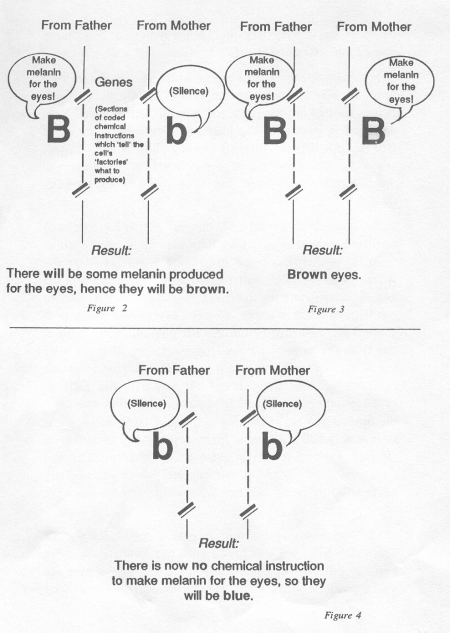
Remember that a sperm from a man, or an egg from a woman, can carry only one half of any pair - if a man's code in relation to his eye color is Bb, then his sperm can carry either b or B. So in Figure 5, we see how eye color can be inherited.
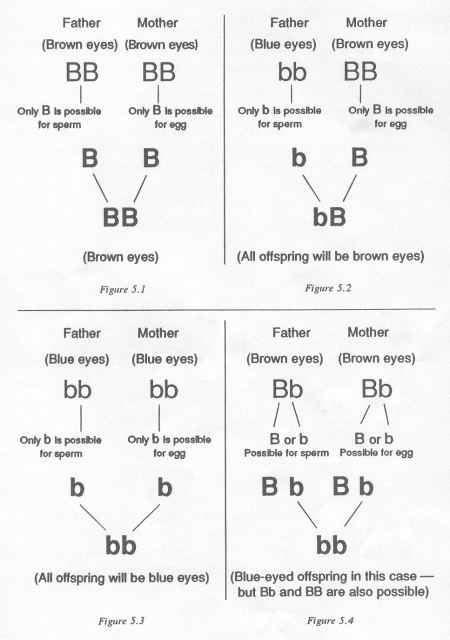
Number 4 is the most interesting. Can you see how a child can be born with blue eyes although both parents have brown eyes? This is because both parents carried the hidden factor for blue eyes, Continuing with Number 4, we can work out what proportion of their offspring on average, should have blue eyes. We do this by means of a simple concept called a punnet square. (Just persevere a little; it becomes relevant to skin color in a moment!) (See Figure 6.)
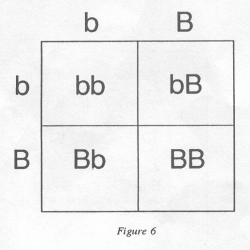
The squares give you the possible combinations in the offspring; it is a little like finding a location from a street map; BB is where the horizontal B meets the vertical B, and so on. You can see that there are three ways to get brown eyes and only one way to get blue. This means that, on average, only one quarter of such a couple's children will have blue eyes.
We know that skin color is governed by at least two (possibly more) sets of genes. Let's call them A and B, with the correspondingly more silent genes a and b, in a similar way to the eye example. (The small letters in this case code for a small amount of melanin.) So a very dark race which, on intermarriage, kept producing only very dark offspring, would be AA BB; the same situation for a very fair-skinned race would be aa bb. Let's look at what combinations would result in a mulatto (the offspring of an AA BB and aa bb union). (See Figure 7.)
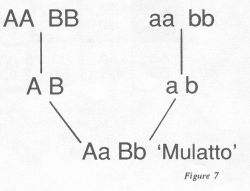
What would happen, by using a punnet square, It two such mid-brown mulatto people were to marry (the shading of the squares roughly indicates the resultant skin color)? (Figure 8.)
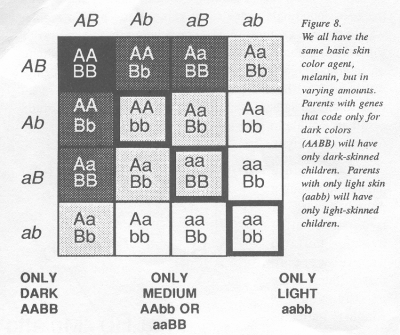
Surprisingly, we find that an entire range of color, from very white to very black, can result in only ONE GENERATION, beginning with this particular type of mid-brown parents.
Those children born with AABB, who are pure black (in the sense of consistently having no other types of offspring), have no genes for lightness at all. If they were to marry and migrate to a place where their offspring could not intermarry with people of different colors, all their children will be black - a pure "black line" will result. Those who are aabb are white; if they marry other whites and migrate to a place where their offspring cannot marry other colors, a pure (in the same sense) "white line" will result - they have lost the genes which give them the ability to be black, that is, to produce a large amount of melanin.
So you can see how it is easily possible, beginning with two middle-brown parents, to get not only all the colors, but also races with permanently different shades of coloring. But what about races which are permanently middle-brown, such as we have today? Again, this is easily explained. Those of aaBB or AAbb, if they no longer interact with others, will be able to produce only mid-brown colored offspring. (You may want to work this out with your own punnet square. )
If these pure lines were to interbreed again with other such lines, the process would be reversed. In a short time, their descendants would show a whole range of colors, often in the same family. The photo in Figure 9 shows what were called Britain's most amazing twins. One is obviously white, the other obviously dark-skinned. Of course, this is not amazing at all when you do the exercise on paper, based on what we have discussed. (A clue if you want to do it yourself; mother cannot be AABB. )
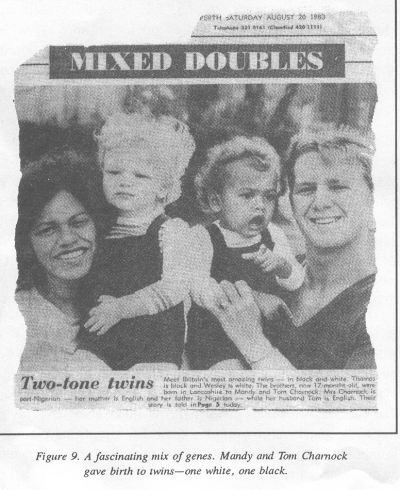
If all the humans on earth were to intermarry freely, and then break into random groups which kept to themselves, a whole new set of combinations could emerge. It may be possible to have almond eyes with black skin, blue eyes with black frizzy short hair, etc. We need to remember, of course, that the way in which genes express themselves is turning out to be much more complex than this simplified picture. Sometimes certain genes are linked together. However, the basic point is unaffected.
Even today, close observation shows that within a particular race you will often see a feature normally associated with another. For instance, you will occasionally see a European with a broad flat nose, or a Chinese with very pale skin. Geneticists who study other, less obvious, characteristics are now aware that the difference between the average of each race is not as great as the existing variation within within each race. This also argues strongly against the idea that the races have been evolving separately for long periods.
We can now reconstruct the true history of the races, using:
The background information given above.
The information given by the Creator Himself in the book of Genesis .
Some consideration of the effect of the environment.
The first created man, Adam, from whom all other humansare descended, was created with the best possible combination of genes - for skin color, for example. A considerable time after creation, a world-wide flood destroyed all humans except a man called Noah, his wife, his three sons, and their wives. This flood greatly changed the environment. Afterwards, God commanded the survivors to multiply and cover the earth. A few hundred years later, men had chosen to disobey God and to remain united in building a great city, with the Tower of Babel as the focal point of rebellious worship. From Genesis 11 we understand that up to this time there was only one language, and that God judged the people's disobedience by imposing different languages on man, so that they could not work together against God, and so that they were forced to scatter over the earth as God had originally intended.
So all the races - the Negro, the European, the Australian Aboriginal, and the others - have come into existence since that time.
Noah and his family were probably mid-brown, with genes for both dark and light skin, because a medium skin color (dark enough to protect against skin cancer, yet light enough to allow vitamin D production) would be the most suitable in the world before the Flood. (It is likely that there were then no harsh extremes of climate.) As all the factors for skin color were present in Adam and Eve, they would most likely have been mid-brown as well. In fact, most of the world's population today is still mid-brown in color.
After the Flood, for the few centuries until Babel, there was only one language and one culture group. Thus, there were no barriers to marriage within this group. This would tend to keep the skin color of the population away from the extremes. Very dark and very light skin would appear, of course, but people tending in either direction would be free to marry someone less dark or less light than themselves, ensuring that the average color stayed roughly the same. The same would be true of other characteristics, not just skin color. Under these sorts of circumstances, distinct racial lines will never emerge. This is true for animals as well as human populations, as every biologist knows. To obtain such separate lines, you would need to break a large breeding group into smaller groups and keep them separate, that is, not interbreeding any more.
This is exactly what happened at Babel. Once separate languages were imposed, there were instantaneous barriers. Not only would people tend not to marry someone they couldn't understand, but entire groups which spoke the same language would have difficulty relating to and trusting those away from each other, into different environments. This, of course, is what God intended. It is unlikely that each small group would carry the same broad range of skin colors as the original, larger group. So one group might have more dark genes, on average, while another might have more light genes. The same thing would happen to other characteristics: nose shape, eye shape, etc. And since they would interbreed only within their own language group, this tendency would no longer be averaged out as before.
As these groups migrated away from Babel, they encountered new and different climate zones. This would also have affected the balance of inherited factors in the population, although the effects of the environment are nowhere near as important as the genetic mix with which each group began. As an example, let us look at people who moved to cold areas with little sunlight. In those areas, the dark- skinned members of any group would not be able to produce enough vitamin D, and thus would be less healthy and have fewer children. So in time, the light-skinned members would predominate. If several different groups went to such an area, and if one group happened to be carrying few genes or lightness, this particular group could in time die out. This natural selection acts on the characteristics already present, and does not evolve new ones.
It is interesting to note that in the Neanderthals of Europe, an extinct race of men now recognized as fully human, virtually all showed evidence of vitamin D deficiency in their bony skeletons. In fact, it was this, plus a large dose of evolutionary prejudice, which helped cause them to be classified as ape-men for a long time. It is thus quite plausible to suggest that they were a dark-skinned race who were unfit for the environment into which they moved because of the skin color genes they began with. (Notice that his natural selection, as it is called, does not produce skin colours, but only acts on the created colors that are already here.)
Conversely, fair-skinned people in very sunny regions could easily be affected by skin cancer, in which case dark - skinned people would more readily survive.
So we see that the pressure of the environment can (a) affect the balance of genes within a group, and (b) even eliminate entire groups. This is why we see, to a large extent, a fit of characters to their environment (e.g. Nordic people with pale skin, equatorial people with dark skin).
But this is not always so. The Eskimo has darkish skin, yet lives where there is not much sun. The pygmy is in a hot area, but rarely experiences sunshine in his dense jungle environment And pygmies may be a good example of another factor which has affected the racial history of man : discrimination. If a variation from the normal occurs (e.g., a very light person in a dark race), then historically it has been usual for that person to be regarded as abnormal and unacceptable. Thus, such a person would find it hard to get a marriage partner. This would further tend to eliminate light genes from a dark race, and vice versa. In this way, groups have tended to "purify" themselves. Also, in some instances, interbreeding in a small group can highlight any commonly occurring unusual features which would previously have been swamped by continual intermarriage. There is a tribe in Africa whose members all have grossly deformed feet as a result of this inbreeding.
To return to pygmies, if people possessing genes for such short stature were discriminated against because of their size, and a small group of them sought refuge in the deepest forest, their marrying only each other would ensure a pygmy race from then on. The fact that pygmy tribes never have their own languages, but instead speak dialects of neighboring non-pygmy tribal languages, is good evidence in support of this.
Human groups that were already equipped with certain characteristics may have made deliberate (or semi-deliberate) choices concerning the environments to which they migrated. For instance, people with genes for a thicker, more insulating layer of fat under their skin would tend to leave areas that were uncomfortably hot.
The evidence for the Bible's account of human origins is more than just biological and genetic. Since all races descended from Noah's family a relatively short time ago, we would be surprised if, in the stories and legends of many of the groups, there was not some memory, albeit distorted by time and retelling, of such a catastrophic event. In fact, an overwhelming number of cultures do have such an account of a world-destroying Flood. Often these have startling parallels to the true, original account (eight people saved in a boat, a rainbow, the sending of the birds, and more).
In summary, the dispersion at Babel, breaking a large interbreeding group into small, inbreeding groups, ensured that the resultant groups would have different mixes of genes for various physical features. By itself, this would ensure, in a short time, that there would be certain fixed differences in some of these groups which we would call separate races. In addition, the selection pressure of the environment would modify the existing combinations of genes, causing a tendency for characteristics to suit their environment. There has been no simple-to-complex evolution of any genes, for the genes were present already. The features of the various races result from different combinations of previously existing created genes, plus some minor changes in the direction of degeneration, resulting from mutation (accidental changes which can be inherited). The originally created (genetic) information has been either reshuffled or degenerated, not added to.